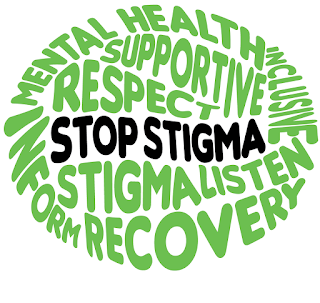There are five levels of stigma that can affect your daily living experiences if you have a mental health disorder.
Stigmatizing beliefs occur on a personal level, in the general public, within professions, via labels and by associative connections.
1. Self Stigma is the self-blame you attach to your identity as being someone who has depression. Whether it's your personal or professional identity, you attach negative self-beliefs about your abilities or worthiness. These pessimistic beliefs can become such a part of your thinking style that you become passive and accepting of their power. In truth, the self-stigma you've assigned yourself is not based in reality. To combat this experience, you need to educate yourself about that mental illness is a REAL illness. Disorders are largely neurobiological issues, not a result of laziness or weak character. Try using these more positive affirmations:
- "Depression is a real medical illness."
- "I am much more than my mental illness."
- "Living with a mental illness offers me greater insight and compassion."
2. Public stigma is the experience where myths and misinformation keep the general public fearful about mental illness. Commercials that make fun of someone with depression or anxiety might sell a product, but we'd all agree it perpetuates stigma. Movies, television shows, newscasts and jokes that use mental illness as a tool for ridicule worsens public stigma. Just like self-stigma, educating the public is the key here. Be it writing a letter, firing off an email, or talking to someone directly, taking on a public stigmatizing experience can become a teachable moment.
3. Professional Stigma occurs when stigmatizing views of mental illness go beyond the general public to the so-called educated levels of professionals. Studies have shown that well-trained professionals from an array of health fields stereotype psychological disorders. To combat professional stigma, don't be afraid to educate. Take your personal knowledge of mental health disorders and help others learn what it's really about. Just because a person is a professional, does not necessarily mean they are truly educated.
4. Label Stigma occurs with the use of diagnostic labels. It's important to note that diagnosis is a meaningful way to identify illness. However, the language of diagnosis can make having a mental illness stigmatizing. For example, "He's schizophrenic" feels more negative as a descriptor than "He is a person who has schizophrenia". Again, put yourself out there and correct the misuses of labels or language that dehumanize.
5. Stigma by Association is the experience of being stigmatized because you know someone who has a mental illness. If you are a family member, friend, coworker, or neighbor of someone who has mental illness, you have the potential for finding yourself socially disqualified from others. Sometimes called courtesy stigma or associative stigma, stigma by association devalues your status because you share an affiliation with a child or adult who has mental illness. If you are someone who has a mental illness, talk to your family and friends and teach them about the stigma by association. Give them permission to address stigma should they feel the need to do so. For example, if your spouse can educate a misinformed person about a mental illness , three things happen. First, your loved one confirms your importance and value. Second, your loved one minimizes stigma by teaching about the realities of mental illness, and third, the stigmatizing person learns a valuable lesson.
Now that you understand how the psychosocial cycle of stigma presses on you, it's time to shift the focus of shame off of your shoulders. As you continue to educate yourself, make the leap to teaching others so that the myths of mental illness can be addressed.
